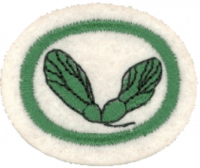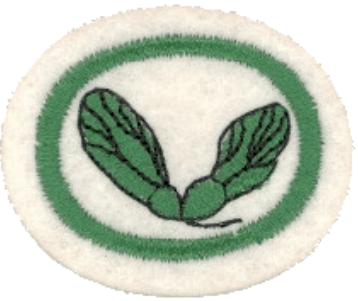Difference between revisions of "AY Honors/Seeds/Lesson Plans"
(Add tips for 4-9) |
|||
| Line 137: | Line 137: | ||
==Procedure== | ==Procedure== | ||
* Fold the paper towel twice lengthwise. Curl into a cylinder and place inside the cup. | * Fold the paper towel twice lengthwise. Curl into a cylinder and place inside the cup. | ||
| − | |||
* Place a bean between the paper towel and the side of the cup. | * Place a bean between the paper towel and the side of the cup. | ||
| − | * Prepare | + | * Prepare four cups & seeds. For cups #1 and #2 simply moisten the paper towel. Fill cup #3 with water to cut off any oxygen. Add no water to cup #4. Place cup #1 in a warm place (room temperature is OK). Place cup#2 in a cold place (such as a refrigerator). |
| − | + | * Check the seeds weekly and observe changes in the seeds. Cup #1 should sprout, and the others should not. | |
| − | * Check the seeds weekly and observe changes in the seeds. | ||
| − | + | Discuss what is needed for a seed to sprout (see the Answer Key). You can do this ahead of time and have the members make predictions as to which seeds will sprout and which ones won't, or you can do it a week or two later after they've been given enough time to sprout. | |
| − | |||
| − | Discuss what is needed for a seed to sprout (see the Answer Key). | ||
<noinclude></translate></noinclude> | <noinclude></translate></noinclude> | ||
Latest revision as of 01:16, 4 March 2022
1
Teaching Tip
Materials:
- White board & markers (or chalkboard & chalk, paper & marker, etc)
- 5 index cards marked with a number, 1 through 5 - each member should have five cards.
Procedure:
Ask the class to brainstorm the purposes of a seed. Write them down as they are offered. Wait until someone suggests that the purpose is to make new plants or propagate the species. If no one offers that suggestion, suggest it yourself.
Once you have the list, discuss each point, asking why each suggestion is or is not important. Then ask the kids to rank the purpose from 1-5, 5 being most important, 1 being least. They can rank these by holding up the cards. Add them all up and record the score on the list next to the suggestion, and then move to the next item.
When all items have been discussed, ask the members which one seems to be the main purpose.
2
Teaching Tip
Materials:
- Bible.
Procedure:
Remind the members that since death was not part of God's original plan, eating meat could also not have been part of His original plan. Ask what God intended for people to eat before sin entered the world. Then have them look up Genesis 1:29. Ask one member to read it aloud.
3
Teaching Tip
Materials:
- Can of Lima beans (or other large, soft seed)
- Small paper plates
- Plastic knives
Procedure:
Prior to class, dissect one of the beans to be sure that you can identify the parts of the seed from the diagram given in the Answer Key. If you cannot, you may need to choose a different seed.
In class, dissect the seed so that everyone can see what you are doing. Point out the seed coat, endosperm, and embryo, and then show whichever parts of the embryo you can identify.
Distribute to each member a bean, a paper plate, and a plastic knife. Have them dissect their own bean and identify the seed coat, embryo, and cotyledon.
4
Materials
- A seed that is blown by wind (dandelion, goldenrod, aster, etc)
- A seed that gets stuck in an animal's fur (cockle burr, beggar ticks)
- A seed that floats (coconut)
- A seed that is incidentally eaten by animals when they eat a fruit (apples, berries, bananas, etc)
- Alternatively, provide pictures or videos of each seed type.
Procedure
Introduce each of the seeds one at a time and ask the members to suggest how each might be dispersed. Guide the discussion as necessary.
5
Materials
- A collection of food-seeds which can be given to the members for their seed collections. See the Answer Key for a list of possibilities.
Procedure
Ask the members to suggest seeds that are used for food. As any that you have brought are mentioned bring them out and place on a table. Be sure to not bring out seeds that are not eaten (such as avocado). If someone suggests a seed that we do not eat (again, avocado) ask if that's a seed we eat. Refer to the Answer Key for a list. Try to discuss 15 seeds so that they might remember 10!
6
Materials
Procedure
6
Materials
- Coconut
- Coconut oil
Procedure
Show the coconut and the coconut oil and explain that the oil is extracted from the coconut. Explain that many seeds are used as sources of oil. See if the kids can suggest some seeds from which we extract cooking oil. Try to get 8-10 correct responses so that they can remember the required 5.
Show a video (or better, watch the one below and re-enact it) of extracting oil from seeds.
Resources
7
Materials
- Several seeds used as spice (see the Answer Key). You might need to shop around (try health food stores). Mustard is seeds are good for this.
Procedure
Have the members smell each seed. If it's not too overpowering, offer them for tasting as well. (Try this yourself ahead of time so you know.)
8
Materials
- Plastic transparent cup
- Paper Towel
- Water!
- Dried beans.
Procedure
- Fold the paper towel twice lengthwise. Curl into a cylinder and place inside the cup.
- Place a bean between the paper towel and the side of the cup.
- Prepare four cups & seeds. For cups #1 and #2 simply moisten the paper towel. Fill cup #3 with water to cut off any oxygen. Add no water to cup #4. Place cup #1 in a warm place (room temperature is OK). Place cup#2 in a cold place (such as a refrigerator).
- Check the seeds weekly and observe changes in the seeds. Cup #1 should sprout, and the others should not.
Discuss what is needed for a seed to sprout (see the Answer Key). You can do this ahead of time and have the members make predictions as to which seeds will sprout and which ones won't, or you can do it a week or two later after they've been given enough time to sprout.
9
There are multiple ways to gather 30 different seed species. Ideally, you could take the members on a nature walk in an area that you know well and which hosts many seeds that you can identify. The person who can do this is a rare breed, so it this is not you, consider the alternatives below.
Materials
- Up to 10 seed packets
- 20 or more items from the grocery store containing seeds
- tomato
- rice
- beans (multiple kinds)
- nuts (multiple kinds)
- apples
- oranges (not naval! - why not?)
- etc... you'll need to shop.
- Display boards
- These can be anything from construction paper to shadow boxes to anything in between.
- Glue (hot melt for large items like walnuts & avocado, white glue for small seeds as in the packets, etc)
- Slips of paper or mailing labels (optional)
Procedure
- Distribute one type of seeds to each member.
- Have them attach the seed to the display board with an appropriate glue (hot melt for large, white glue for small).
- If you have labels, have the members write the name of the seed, date collected (etc) on the labels. Otherwise, have them write directly on the display board.
For best results, prepare a board yourself ahead of time and show the members what they are trying to create.
Additional Activities to Make this Memorable
Create seed art pictures. Do an image search on the Internet for examples. This is an excellent use of the left-over seeds you are bound to have.


